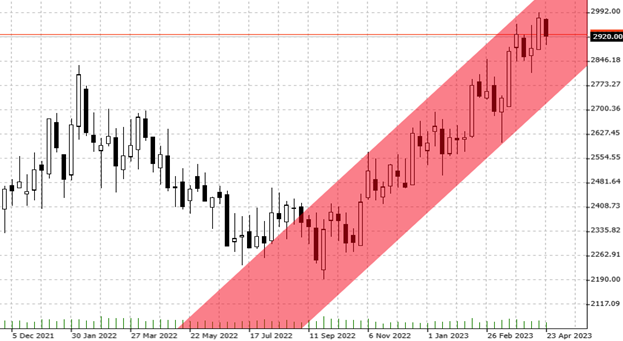

28.04.2023 – The price of cocoa has recently staged an impressive rally. Just like other soft commodities. The threat of a continuing undersupply could give further impetus to the bull market. We analyze the background.
Joy for the bulls: Currently, the price per ton is at its highest level since autumn 2016, the weekly chart also shows a rather steep upward channel that started in the previous September.

Source: Bernstein Bank GmbH
According to the International Cocoa Organiszation’s previous quarterly report from late February, the world is facing a slight demand overhang. For the 2022/23 season, the organization noted a global supply of 5.017 million metric tons. Meanwhile, demand is expected to climb 1 percent to 5.027 million tons. The ICCO’s next quarterly report is due at the end of May, so traders should watch for that.
Little rain and a virus
Let’s turn to supply first. Côte d’Ivoire is by far the top producer, accounting for just under half of global production, with Ghana and Indonesia following behind. The biggest factors affecting price are weather, possible disease in the crop, and government regulation.
Trade is currently determined by the product that reached the market at the end of the main season in March – and things did not look good there. As early as mid-February, the Ivorian regulatory authority Cocoa and Coffee Council (CCC) warned that many local exporters would not be able to meet their export quotas. This was because there were too few beans, as there had been too little rain in recent months. As a result, Ivory Coast had banned twenty major buyers from increasing their quotas, including Cargill and Barry Callebaut.
Hopes now rest on the mid-season from April to September after light rains. However, some sources recently called weather conditions erratic. And there is another bullish factor: Côte d’Ivoire in particular has been plagued by the so-called Cocoa Swollen Shoot Virus Disease (CSSVD) in recent months, which is having a negative impact on both the current crop and new sowings, and is therefore likely to have an impact in the future.
Inflation and consumption
With that, let’s look briefly at the demand side. The USA, the Netherlands and the UK are the biggest buyers of the beans. Cocoa is used, on the one hand, in chocolate, that is clear. But it is also used in cosmetics, because cocoa butter is the only butter that melts at body temperature.
And that brings us to the two factors in the retail sector: If inflation in the West remains annoyingly high or even rises, there is a risk of demand being choked off. After all, unlike a staple food like bread, customers may well do without chocolates or a new skin cream for a while. However, when inflation cools down, demand is likely to pick up.
Our conclusion from all this: keep an eye on real-time news, focus on Ivorian agriculture. Bernstein Bank wishes successful trades and investments!
_____________________________________________________________________________________________________
The content of this publication is for general information purposes only. In this context, it is neither an individual investment recommendation or advice nor an offer to purchase or sell securities or other financial products. The content in question and all the information contained therein do not in any way replace individual investor- or investment-oriented advice. No reliable forecast or indication for the future is possible with respect to any presentation or information on the present or past performance of the relevant underlying assets. All information and data presented in this publication are based on reliable sources. However, Bernstein Bank does not guarantee that the information and data contained in this publication is up-to-date, correct and complete. Securities traded on the financial markets are subject to price fluctuations. A contract for difference (CFD) is also a financial instrument with leverage effect. Against this backdrop, CFD trading involves a high risk up to the point of total loss and may not be suitable for all investors. Therefore, make sure that you have fully understood all the correlating risks. If necessary, ask for independent advice. CFDs are complex instruments and are associated with the high risk of losing money quickly because of the leverage effect. 68% of retail investor accounts lose money trading CFD with this provider. You should consider whether you understand how CFD work and whether you can afford to take the high risk of losing your money.7
